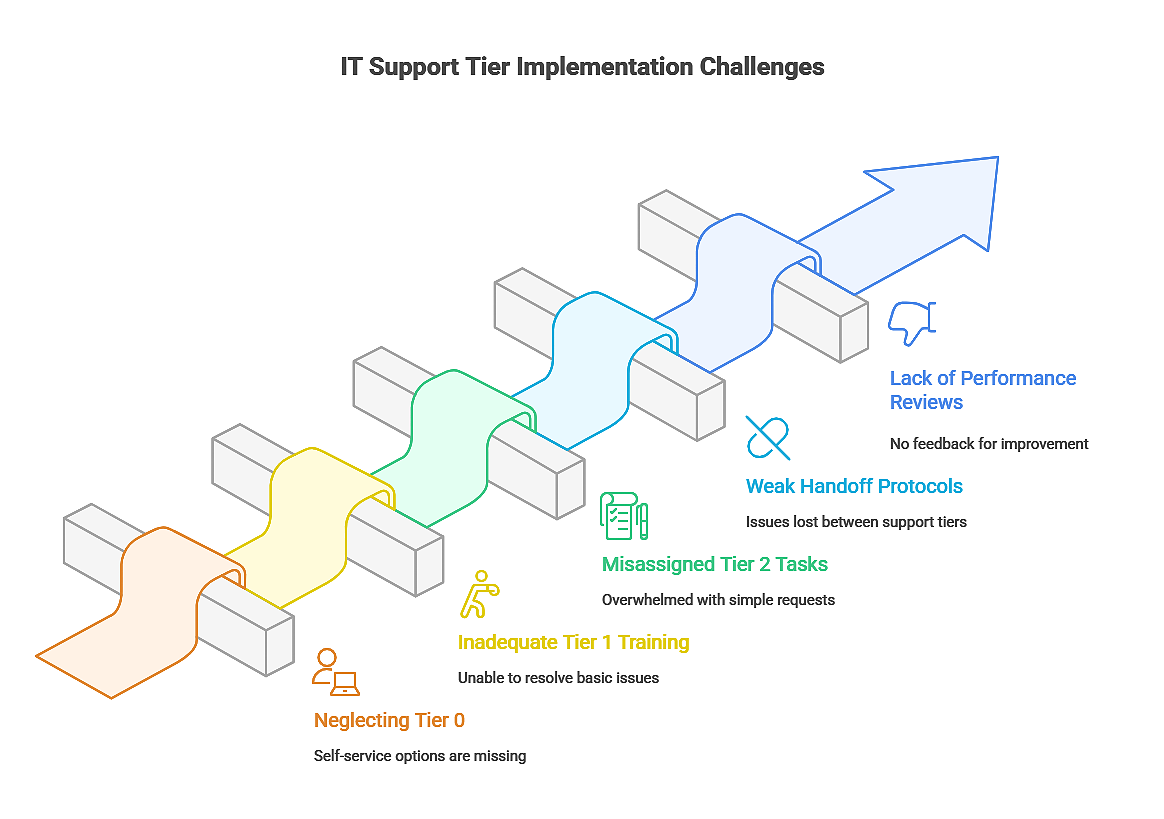

Breaking Down Who Handles What Across IT Support Tiers
When your business IT systems go down, the cost is immediate and steep. According to IBM, a staggering 98% of companies now lose over $100K every time IT breaks down. Yet many companies still rely on a single, catch-all support team, leading to frustrated employees, missed deadlines, and burned-out technicians.
|
“True IT maturity begins when support stops reacting and starts routing every problem, every time, to the right mind.” – Eric Hullibarger, President, AhelioTech |
Tiered IT support is a strategy. When issues are assigned based on complexity and expertise, you resolve problems faster, improve employee performance, and deliver consistent service to customers.
In this blog, you’ll learn:
-
What each IT support tier actually does
-
How structured tiers improve resolution speed and reliability
-
Common mistakes businesses make when implementing support tiers
-
Actionable steps to build a tiered system that works
Let’s break down the tiers of IT support and show you how a smart support structure transforms your tech from reactive to resilient.
What Are IT Support Tiers?
IT support tiers organize your technical team into structured levels, each responsible for resolving issues based on complexity and expertise. Unlike traditional one-size-fits-all support models, where every technician juggles every problem, a tiered approach streamlines resolution and prevents burnout.
When implemented correctly, this structure delivers tangible benefits across your organization. For example:
-
Tickets are routed directly to the right skill level, reducing wait times and enabling faster issue resolution.
-
Technicians focus on tasks they’re trained for, which improves morale and reduces burnout.
-
Teams spend less time guessing and more time solving, boosting overall operational efficiency.
-
Fewer unresolved tickets means less downtime and lost revenue, helping reduce risk.
Tiered support is a strategic framework. It brings clarity to your support process, enables predictable performance, and lays the foundation for scalable, resilient IT operations.
|
Find Out More About How You Can Make Your Business IT Easier to Manage |
Tier 0: Self-Service Support
81% prefer to fix problems themselves before reaching out for help. Tier 0 support empowers users to solve simple issues independently, without needing to contact a live agent. This includes resources like FAQs, knowledge bases, AI chatbots, and self-service portals.
When implemented effectively, Tier 0 can resolve a large volume of recurring, low-complexity tickets, freeing up your human staff for more advanced tasks. This approach not only reduces help desk strain but also delivers immediate value to users. It builds confidence in your internal systems and encourages self-reliance.
Here are some of the most effective ways Tier 0 support delivers results:
-
Reduces repetitive calls to your help desk
-
Delivers instant solutions without human intervention
-
Boosts user confidence and familiarity with systems
To make Tier 0 truly effective, your business should deploy tools that are intuitive and accessible. These typically include:
-
Knowledge Bases: Indexed articles answering common questions like password resets and login issues
-
Chatbots: Guided interactions for basic troubleshooting and navigation
-
Self-Service Portals: Interfaces for ticket submission, account management, and software guidance
Tier 1: Basic Support
Tier 1 is the first human point of contact for IT issues. Staff at this level handle straightforward problems such as account setup, printer malfunctions, and basic application questions. Their role is not only to resolve common issues but also to escalate more complex ones efficiently when needed.
To keep operations running smoothly, Tier 1 agents typically:
-
Apply pre-defined solutions and scripts
-
Escalate unresolved issues to higher tiers without delay
-
Maintain detailed ticket logs for future reference and analysis
Supporting these responsibilities are tools that streamline communication and resolution. These often include:
-
Ticketing Systems: Used to track, assign, and log user issues
-
Live Chat or Email: Channels for direct communication and basic troubleshooting
-
Documentation: Step-by-step guides, scripts, and checklists to ensure consistency
Tier 0 and Tier 1 work in tandem to filter out simple issues and reduce the burden on senior technicians. When functioning properly, they dramatically cut ticket volume and allow higher tiers to focus on complex, high-impact problems.
Tier 2: Technical Support
62% of users now see Insight and know-how as the core of good support. Tier 2 steps in when issues exceed the scope of Tier 1. Technicians at this level possess deeper knowledge of systems and applications, allowing them to perform more advanced diagnostics and interventions.
This tier plays a vital role in bridging basic support and expert-level troubleshooting. It also strengthens your support ecosystem by:
-
Reducing Tier 3 workload through the resolution of intermediate issues
-
Improving documentation for recurring problems
-
Acting as a buffer between general support and specialized intervention
Real-world examples of Tier 2 tasks include:
-
Diagnosing recurring VPN connection failures
-
Resolving complex user permissions issues
-
Applying patches to fix software bugs and improve system stability
|
Turn Your IT Desk Into a Problem-Solving Powerhouse |
Tier 3: Expert Support
Tier 3 is staffed by highly specialized technicians, system architects, or engineers. These experts tackle the most complex and high-stakes issues, largely those that lower tiers cannot resolve. Their focus is on root cause analysis, problem replication, and advanced troubleshooting.
At this level, responsibilities often include:
-
Debugging persistent ERP or database errors
-
Collaborating with developers to implement long-term fixes
-
Updating Tier 1 and Tier 2 documentation with tested solutions
-
Documenting Tier 2 and Tier 3 actions is a strategic advantage. It:
-
Builds a knowledge repository for lower tiers
-
Reduces repetitive escalations and support fatigue
-
Speeds up future resolutions with pre-tested solutions
Tier 4: External IT Support
Tier 4 involves vendors or third-party providers and is activated when internal teams lack the access or expertise to resolve specific software or hardware issues. This tier is essential for proprietary systems, licensed platforms, and manufacturer-level diagnostics.
Some common Tier 4 scenarios include:
-
Vendor-specific SaaS troubleshooting
-
Hardware diagnostics requiring manufacturer intervention
-
Licensing or account support from third-party vendors
Because Tier 4 relies on external parties, it demands rigorous oversight. Internal teams must:
-
Track external tickets closely to avoid delays
-
Communicate status updates to affected users
-
Ensure service-level agreements (SLAs) are met to minimize downtime
For example, if a backup system fails due to vendor software issues, Tier 4 intervention is required. With proper monitoring, the disruption is contained and resolved efficiently. While Tier 4 provides access to deep expertise, it also introduces dependency risks, making coordination and accountability critical.
Key Differences Between IT Technical Support Tiers
Understanding the distinctions between support tiers enables businesses to assign responsibilities, set clear expectations, and maintain high service quality.
Here’s a breakdown of how each tier differs in scope, skill level, tools, and response time:
|
Tier |
Responsibility |
Skill Level |
Tools |
Escalation |
Typical Response |
|---|---|---|---|---|---|
|
0 |
Self-service solutions |
Users |
Knowledge base, chatbots, portals |
N/A |
Immediate |
|
1 |
Basic troubleshooting |
Junior staff |
Ticketing, email, scripts |
Escalate if unresolved |
15–30 mins |
|
2 |
Advanced technical support |
Experienced techs |
RMM tools, admin dashboards |
Escalate if complex |
1–4 hours |
|
3 |
Expert problem-solving |
Senior engineers |
Test environments, diagnostic suites |
Only escalate to vendors |
1 day+ |
|
4 |
Vendor/third-party |
External specialists |
Vendor portals, licensing logs |
Track follow-up |
Depends on SLA |
This structure ensures that each issue is handled by the right level of expertise—preventing delays, improving response times, and reducing stress across your IT team.
Setting Up Effective IT Support Tiers
Building a tiered support system requires thoughtful planning and ongoing refinement. Here’s how to get started:
-
Audit IT requests to identify frequent issues and classify them by complexity
-
Assign ticket types to the appropriate tier based on resolution needs
-
Train staff per tier to ensure their expertise matches their responsibilities
-
Document processes to maintain clear escalation and resolution records
-
Track performance using metrics like first-time resolution, ticket volume, and handoff quality
When structured properly, tiered support saves time, reduces errors, and lowers operational costs, while dramatically improving user satisfaction. Most times, outsourcing your IT support is the most efficient. Roughly 46% of businesses say outsourcing gives them access to expertise they can’t find in-house.
Common Missteps in IT Support Tiers

Even with the best intentions, many businesses struggle to implement tiered support effectively. These missteps often lead to inefficiencies, frustrated users, and overburdened teams.
Some of the most common pitfalls include:
-
Neglecting Tier 0: Without self-service options, Tier 1 becomes overwhelmed with avoidable tickets.
-
Inadequate Tier 1 training: Poorly prepared staff cause delays and escalate issues unnecessarily.
-
Misassigned Tier 2 tasks: Junior staff handling advanced problems often result in mistakes and inefficiency.
-
Weak handoff protocols: When issues aren’t clearly documented, users are forced to repeat themselves, wasting time and eroding trust.
Lack of performance reviews: Without regular evaluation, teams miss opportunities to improve processes and outcomes.
Recognizing and addressing these challenges ensures your support structure runs efficiently and consistently delivers value to users.
Benefits of Tiered IT Support for Businesses
When implemented correctly, structured IT support tiers offer measurable advantages that go beyond faster ticket resolution. They create a scalable, resilient support system that benefits both internal teams and external users.
Key benefits include:
-
Faster issue resolution through accurate tier assignment and streamlined workflows
-
Clear escalation paths that reduce frustration and confusion
-
Higher employee satisfaction and retention by aligning tasks with skill levels
-
Consistent service reliability that builds user trust, even during outages
-
Operational visibility and control that improves workload management and resource planning
IT Support Tier Metrics
To ensure each tier is functioning optimally, it’s essential to track performance. The table below outlines key metrics that help benchmark efficiency, workload distribution, and training investment:
|
Tier |
Average Ticket Volume |
Resolution Time |
Customer Satisfaction |
Staff Training Hours |
|---|---|---|---|---|
|
0 |
40–50% of total tickets |
Instant |
85%+ |
10–15 hours/year |
|
1 |
30–35% |
15–30 mins |
80% |
30–40 hours/year |
|
2 |
15–20% |
1–4 hours |
90% |
50–60 hours/year |
|
3 |
5–10% |
1 day+ |
95% |
80+ hours/year |
|
4 |
1–5% |
SLA-dependent |
Varies |
Vendor-led |
These benchmarks help you identify gaps, allocate resources wisely, and continuously improve your IT support structure.
Experience Tiered IT Support Advantage with AhelioTech
A well-structured IT support system is a business advantage. From Tier 0 self-service to Tier 4 vendor coordination, each level plays a vital role in reducing delays, improving service quality, and ensuring your team focuses on the right problems.
Businesses that implement clear, strategic tiers consistently report:
-
Faster ticket resolution
-
Improved employee morale
-
Greater operational reliability
|
Work With Some of Ohio’s Top IT Support Specialists |
AhelioTech offers tiered IT support that delivers measurable results. With 24 expert IT technicians on staff, ranging from Tier 1 to Tier 4, and 18 years of industry experience, our clients enjoy faster issue resolution, reliable service, and structured support that scales with their business.”
Contact us today to schedule a consultation. Entrust your business to a resilient support system that keeps your operations running smoothly.
